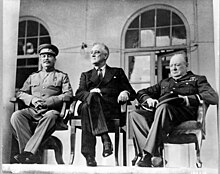Uni Soviet pada Perang Dunia II



Uni Soviet menandatangani sebuah pakta non-agresi dengan Jerman Nazi pada 23 Agustus 1939. Selain stipulasi non-agresi, traktat tersebut meliputi protokol rahasia yang membagi teritorial-teritorial Rumania, Polandia, Lithuania, Latvia, Estonia, Belarus, Ukraina, dan Finlandia ke dalam "lingkup pengaruh" Soviet dan Jerman, mengantisipasi "rearansemen teritorial dan politik" potensial dari negara-negara tersebut.[1] Joseph Stalin dan Adolf Hitler kemudian mendagangkan proporsal-proporsal setelah masuknya Soviet ke Pakta Blok Poros.
Catatan[sunting | sunting sumber]
- ^ "chathamhouse.org, 2011". Diarsipkan dari versi asli tanggal 2015-12-08. Diakses tanggal 2018-01-03.
Referensi[sunting | sunting sumber]
- Brackman, Roman (2001), The Secret File of Joseph Stalin: A Hidden Life, Frank Cass Publishers, ISBN 0-7146-5050-1
- Brent, Jonathan; Naumov, Vladimir (2004), Stalin's Last Crime: The Plot Against the Jewish Doctors, 1948–1953, HarperCollins, ISBN 0-06-093310-0
- Henig, Ruth Beatrice (2005), The Origins of the Second World War, 1933–41, Routledge, ISBN 0-415-33262-1
- Lewkowicz Nicolas, The German Question and the Origins of the Cold War (IPOC, Milan) (2008) ISBN 8895145275
- Merridale, Catherine (2007). Ivan's War: Life and Death in the Red Army, 1939–1945. Macmillan. ISBN 978-0-312-42652-1.
- Murphy, David E. (2006), What Stalin Knew: The Enigma of Barbarossa, Yale University Press, ISBN 0-300-11981-X
- Nekrich, Aleksandr Moiseevich; Ulam, Adam Bruno; Freeze, Gregory L. (1997), Pariahs, Partners, Predators: German-Soviet Relations, 1922–1941, Columbia University Press, ISBN 0-231-10676-9
- Roberts, Geoffrey (2006), Stalin's Wars: From World War to Cold War, 1939–1953, Yale University Press, ISBN 0-300-11204-1
- Roberts, Geoffrey (2002), Stalin, the Pact with Nazi Germany, and the Origins of Postwar Soviet Diplomatic Historiography, 4 (4)
- Roberts, Geoffrey (1992), "The Soviet Decision for a Pact with Nazi Germany", Soviet Studies, 55 (2), JSTOR 152247
- Rottman, Gordon (2007), Soviet Rifleman 1941-1945, Osprey, ISBN 978-1846031274
- Soviet Information Bureau (1948), Falsifiers of History (Historical Survey), Moscow: Foreign Languages Publishing House, 272848
- Department of State (1948), Nazi-Soviet Relations, 1939–1941: Documents from the Archives of The German Foreign Office, Department of State
- Taubert, Fritz (2003), The Myth of Munich, Oldenbourg Wissenschaftsverlag, ISBN 3-486-56673-3
- Watson, Derek (2000), "Molotov's Apprenticeship in Foreign Policy: The Triple Alliance Negotiations in 1939", Europe-Asia Studies, 52 (4), JSTOR 153322
- Wettig, Gerhard (2008), Stalin and the Cold War in Europe, Rowman & Littlefield, ISBN 0-7425-5542-9
Dalam negeri[sunting | sunting sumber]
- Abramov, Vladimir K. "Mordovia During the Second World War," Journal of Slavic Military Studies (2008) 21#2 pp 291–363.
- Annaorazov, Jumadurdy. "Turkmenistan during the Second World War," Journal of Slavic Military Studies (2012) 25#1 pp 53–64.
- Barber, John, and Mark Harrison. The Soviet Home Front: A Social and Economic History of the USSR in World War II, Longman, 1991.
- Berkhoff, Karel C. Harvest of Despair: Life and Death in Ukraine Under Nazi Rule. Harvard U. Press, 2004. 448 pp.
- Braithwaite, Rodric. Moscow 1941: A City and Its People at War (2006)
- Thurston, Robert W., and Bernd Bonwetsch (Eds). The People's War: Responses to World War II in the Soviet Union (2000)
- Dallin, Alexander. Odessa, 1941–1944: A Case Study of Soviet Territory under Foreign Rule. Portland: Int. Specialized Book Service, 1998. 296 pp.
- Ellmana, Michael, and S. Maksudovb. "Soviet deaths in the great patriotic war: A note," Europe-Asia Studies (1994) 46#4 pp 671–680 DOI:10.1080/09668139408412190
- Glantz, David M. (2001). The Siege of Leningrad, 1941–1944: 900 Days of Terror. Zenith. ISBN 978-0-7603-0941-4.[pranala nonaktif permanen]
- Hill, Alexander. "British Lend-Lease Aid and the Soviet War Effort, June 1941 – June 1942," Journal of Military History (2007) 71#3 pp 773–808.
- Overy, Richard. Russia's War: A History of the Soviet Effort: 1941–1945 (1998) 432pp excerpt and txt search
- Reese, Roger R. "Motivations to Serve: The Soviet Soldier in the Second World War," Journal of Slavic Military Studies (2007) 10#2 pp 263–282.
- Thurston, Robert W. & Bernd Bonwetsch (2000). The People's War: Responses to World War II in the Soviet Union. U. of Illinois Press. ISBN 978-0-252-02600-3.
- Vallin, Jacques; Meslé, France; Adamets, Serguei; and Pyrozhkov, Serhii. "A New Estimate of Ukrainian Population Losses During the Crises of the 1930s and 1940s." Population Studies (2002) 56(3): 249–264. JSTOR 3092980 Reports life expectancy at birth fell to a level as low as ten years for females and seven for males in 1933 and plateaued around 25 for females and 15 for males in the period 1941–44.
Sumber primer[sunting | sunting sumber]
- Bidlack, Richard, and Nikita Lomagin, eds. The Leningrad Blockade, 1941–1944: A New Documentary History from the Soviet Archives. Yale U.P.
- Hill, Alexander, ed. The Great Patriotic War of the Soviet Union, 1941–45: A Documentary Reader (2011) 368pp
Wikimedia Commons memiliki media mengenai World War II.
